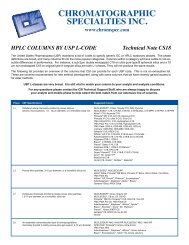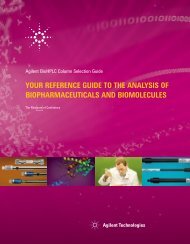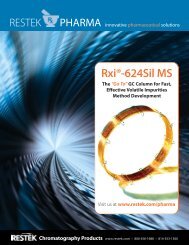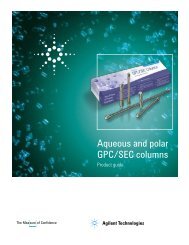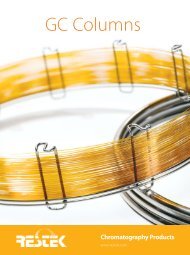Optimizing the Analysis of Volatile Organic Compounds
Optimizing the Analysis of Volatile Organic Compounds
Optimizing the Analysis of Volatile Organic Compounds
Create successful ePaper yourself
Turn your PDF publications into a flip-book with our unique Google optimized e-Paper software.
Detection Systems<br />
VOCs can be analyzed using a variety <strong>of</strong> detection systems, including GC/MS, GC/PID, and<br />
GC/ELCD. Here, we discuss consequences <strong>of</strong> using each <strong>of</strong> <strong>the</strong>se systems, and present tips<br />
for maintenance and troubleshooting.<br />
Column Configurations<br />
Single Column: Environmental engineers characterize a contaminated site using MS or<br />
dual-column GC, or <strong>the</strong>y might monitor <strong>the</strong> site solely with single-column GC methods.<br />
Injections <strong>of</strong> standards on a single column, delivered to <strong>the</strong> detector, can provide tentative<br />
identification and quantification. Retention times for analytes listed in a given method are<br />
established by injecting a check standard containing all <strong>of</strong> <strong>the</strong> target compounds. Retention<br />
times for analytes in site samples are compared against retention times for <strong>the</strong> standard, to<br />
verify if unknown compounds match known targets. A single column configuration works<br />
well with characterized samples, but retention times are not unique for every analyte, especially<br />
for early-eluting compounds that spend little time in <strong>the</strong> stationary phase (e.g., Freon ®<br />
compounds). In environmental laboratories coelutions from non-target compounds also are<br />
very common, creating very complex chromatograms that are difficult to interpret using a<br />
single-column design.<br />
Dual Columns: In a dual-column configuration, <strong>the</strong> sample passes through a fused silica<br />
guard column, <strong>the</strong>n is split between two analytical columns <strong>of</strong> differing selectivity.<br />
Standards are injected to establish retention times on both columns simultaneously. One disadvantage<br />
to this configuration is <strong>the</strong> 50% loss in sensitivity resulting from splitting <strong>the</strong><br />
sample. This loss can be overcome by increasing <strong>the</strong> sample volume or by optimizing <strong>the</strong><br />
detector. Flow rates for <strong>the</strong> two columns should agree within 20% because uneven splitting<br />
will fur<strong>the</strong>r affect sensitivity.<br />
Detector Configurations<br />
Detectors can be connected in parallel, in series, or in tandem, to double <strong>the</strong> amount <strong>of</strong><br />
information about <strong>the</strong> sample.<br />
Parallel System: In a parallel system <strong>the</strong> sample is split equally between <strong>the</strong> two detectors,<br />
allowing both detectors to be destructive (e.g., ELCD/FID). This detection system works<br />
well but is unsuitable for a dual-column analytical configuration because <strong>the</strong> sample already<br />
will have been split between <strong>the</strong> two columns.<br />
Series System: Series detection involves connecting two detectors in sequence, using a short<br />
length <strong>of</strong> deactivated metal or fused silica tubing. The sample passes through <strong>the</strong> first detector,<br />
which must be non-destructive (e.g., PID), <strong>the</strong>n through <strong>the</strong> second detector. This produces<br />
two sets <strong>of</strong> information about <strong>the</strong> sample with no loss in sensitivity because <strong>the</strong> sample<br />
volume does not change from <strong>the</strong> first detector to <strong>the</strong> second. The only disadvantage is<br />
dead volume, which can broaden <strong>the</strong> peaks. Minimize dead volume by minimizing <strong>the</strong><br />
length and ID <strong>of</strong> <strong>the</strong> line connecting <strong>the</strong> detectors.<br />
Tandem System: The tandem configuration connects two detectors without <strong>the</strong> dead volume<br />
associated with a series system. The non-destructive first detector is <strong>the</strong> base for <strong>the</strong> second<br />
detector. The units can be connected to a single detector port on one GC. This makes it possible<br />
to use a dual-column configuration, with each column connecting to tandem detectors,<br />
producing four sets <strong>of</strong> data per analysis. This approach is used in EPA Method 8021. 9<br />
Detectors: Method requirements determine <strong>the</strong> choice <strong>of</strong> detector(s). The current shift<br />
toward analysis by performance-based criteria makes it possible to use detection o<strong>the</strong>r than<br />
that listed in a method if it can be shown that performance is similar to, or better than, what<br />
would be attained by following <strong>the</strong> guidelines in <strong>the</strong> method. The most common GC detectors<br />
are <strong>the</strong> PID, <strong>the</strong> FID, and <strong>the</strong> ELCD. GC/MS eliminates <strong>the</strong> need for a confirmation<br />
column.<br />
9. R.D. Braun. Introduction to Instrumental <strong>Analysis</strong>. McGraw-Hill Book Company. New York. 1987.<br />
pp. 915-916.<br />
23<br />
www.restekcorp.com





